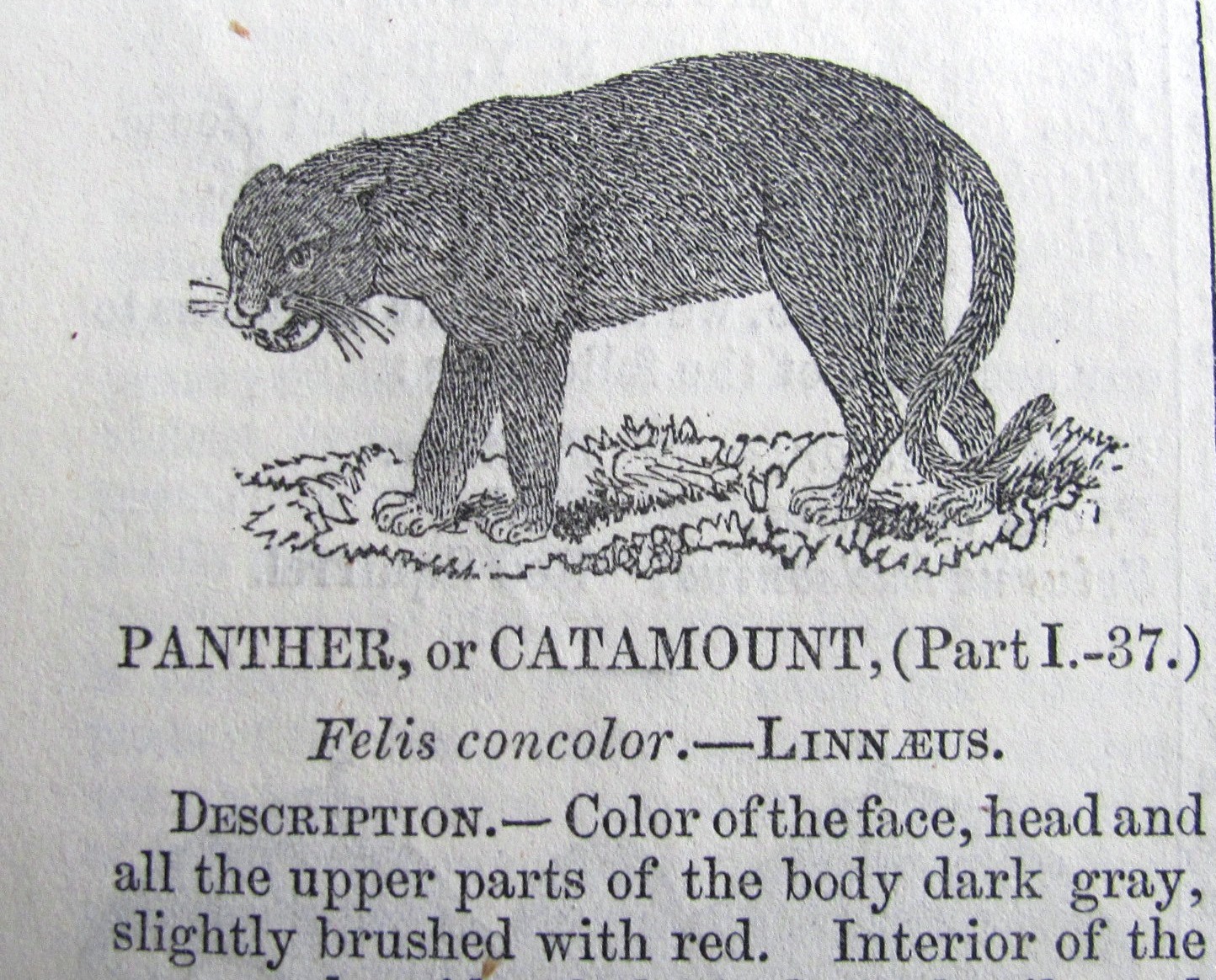Last week I wrote about Zadock Thompson’s 1842 “History of Vermont.” You may recall I wrote about panthers recorded in Thompson’s history. To his history, I added what I knew about the 1867 Perkinsville and 1881 Barnard panthers. The 1881 panther was the last panther killed in Vermont.
Do you remember a grade school field trip to Montpelier, to visit the Vermont Historical Society Museum? I remember the Barnard panther, as does Ted Spaulding. Do you?
In 1853, Thompson published “Thompson’s Vermont Appendix 1853.”
This is basically a reprint of his 1842 book, but with additions and new discoveries. He records the coming of the railroad and the magnetic telegraph. I also found another panther history. Thompson examined this panther and documented it in detail. The list grows.
“PANTHER, or CATAMOUNT
“Felis concolor. – Linnaeus

“Description. – Color of the face, head and all the upper parts of the body dark gray, slightly brushed with red. Interior of the ears, under side of the body and tail, and inner side of the legs grayish ash; between the hind legs and beneath the tail tawny white. Exterior of the ears, bottoms of the feet and extremity of the tail black.
“Also a black patch on each side of the nose, from which the whiskers proceed, and the two connected by a brownish band over the nose. Chin, lower lip and part of the upper lip clear white. Nose naked, of a brownish copper color, and narrowly margined with white hairs. Whiskers 2 ½ inches long, white, intermingled with a few black hairs.
“Eyes oblique, with a whitish spot above and a little in front of each, and a smaller one below. Irises orange. Claws completely retractile, one inch long, very strong and sharp, of a pearly white color, having a blood red tinge on the under side near the base.
“Teeth all clear white, perfectly sound, exhibiting no marks or wear. Incisors small, outer ones largest. Canines conical and strong, projecting 1.1 inch beyond the gum. The carnivorous molars project ¾ of an inch. Posterior molars in the upper jaw not fully developed. The weight of the specimen before me, which is a male, is 86 pounds.
“Length, from the nose to the root of the tail, 48 inches. Length of the tail (vertebrae 29.5, skin and hair beyond 1.5) 31. Total length 79 in., or 6ft. 7 in. Length of facial line, from nose to occiput, 10. Width of the head between the ears, posteriorly, 4.5, anteriorly 6, between the eyes 2.5. Height of the rounded ear 3.5. Length of the humerus 8, fore-arm 9, thigh 11, leg 12. Circumference of the wrist 7.5, fore paw 7.5, ankle 6, hind foot 7. Height at shoulders 26, at the rump 27. Girt of neck 16 inches, just behind the fore legs 27 inches.
“History. – The panther here described, was caught on the western slope of the Green Mountains, in the town of Manchester, Bennington county, on the 5th day of February, 1850. It was taken by a Mr. Burritt, in a trap set for a bear.
“It was purchased by the Hon. L. Sargeant and a few others in Manchester, who, with a public spirit and zeal for the advancement of science truly commendable and worthy of imitation, presented it to the Museum of the University of Vermont, where its skin and skeleton are now preserved.
“In taking off the skin, the head, neck and inner sides of the fore legs were found very much filled with Hedge-Hog quills, which, in many cases, had passed entirely through the skin and were deeply embedded in the flesh. [Author’s note: I have a quill story.]
“The teeth of this Panther were all perfectly sound and white, showing no marks or wear, and as the posterior molars in the upper jaw were not fully developed, there can be no doubt that it was a young animal, probably about two years old.
“The Panther, above described, is the last and the only one which has been, to my knowledge, killed in Vermont for many years; and as the animal is now exceedingly scarce, and there may never be another obtained, within the state for any of our museums, I have thought it advisable to be thus minute in its description and history, notwithstanding the full general account in Part 1 – p. 37.”
This week’s old saying is about a gossiper: “A dog that will bring a bone will carry a bone.”